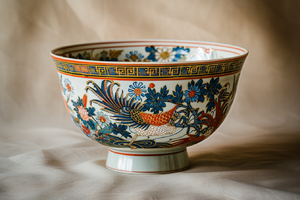โค อิมาริ
Ko-Imari

โค-อิมาริ (แปลตรงตัวว่า อิมาริโบราณ) หมายถึงเครื่องปั้นดินเผาอิมาริญี่ปุ่นยุคแรกเริ่มและเป็นเอกลักษณ์ที่สุด ซึ่งผลิตขึ้นในช่วงศตวรรษที่ 17 เครื่องปั้นดินเผาเหล่านี้ผลิตขึ้นที่เมืองอาริตะและส่งออกจากท่าเรืออิมาริที่อยู่ใกล้เคียง ซึ่งเป็นที่มาของชื่อเครื่องปั้นดินเผานี้ โค-อิมาริโดดเด่นเป็นพิเศษด้วยรูปแบบการตกแต่งที่มีชีวิตชีวาและความสำคัญทางประวัติศาสตร์ในยุคแรกเริ่มของการค้าเครื่องปั้นดินเผาทั่วโลก
ภูมิหลังทางประวัติศาสตร์
เครื่องปั้นดินเผาโคอิมาริถือกำเนิดขึ้นในช่วงต้นยุคเอโดะ ประมาณช่วงคริสต์ทศวรรษ 1640 หลังจากการค้นพบดินเผาในแถบอาริตะ เดิมทีได้รับอิทธิพลจากเครื่องปั้นดินเผาสีน้ำเงินและสีขาวของจีน ช่างปั้นชาวญี่ปุ่นในท้องถิ่นจึงเริ่มพัฒนาเอกลักษณ์เฉพาะของตนเอง เมื่อการส่งออกเครื่องปั้นดินเผาของจีนลดลงเนื่องจากการล่มสลายของราชวงศ์หมิง เครื่องปั้นดินเผาของญี่ปุ่นจึงเริ่มเข้ามาเติมเต็มช่องว่างในตลาดต่างประเทศ โดยเฉพาะอย่างยิ่งผ่านการค้ากับบริษัทดัตช์อีสต์อินเดีย
คุณสมบัติหลัก
คุณสมบัติที่โดดเด่นของโคอิมาริมีดังนี้:
- Bold and colorful designs, typically combining cobalt blue underglaze with overglaze enamels in red, green, and gold.
- Dense and symmetrical decoration covering nearly the entire surface, often described as richly ornate or even opulent.
- Motifs such as chrysanthemums, peonies, phoenixes, dragons, and stylized waves or clouds.
- Thick porcelain body compared to later, more refined pieces.
Ko-Imari ware was not intended solely for domestic use. Many pieces were tailored to suit European tastes, which included large plates, vases, and garnitures for display.
Export and European Reception
Ko-Imari ware was exported in large quantities throughout the 17th and early 18th centuries. It became a fashionable luxury item among European elites. In palaces and aristocratic homes across Europe, Ko-Imari porcelain adorned mantelpieces, cabinets, and tables. European porcelain manufacturers, particularly in Meissen and Chantilly, began producing their own versions inspired by Ko-Imari designs.
Evolution and Transition
By the early 18th century, the style of Imari ware began to evolve. Japanese potters developed more refined techniques, and new styles such as Nabeshima ware emerged, focusing on elegance and restraint. The term Ko-Imari is now used to specifically distinguish these early exported works from later domestic or revival pieces.
Legacy
Ko-Imari remains highly valued by collectors and museums worldwide. It is considered a symbol of Japan’s early contribution to global ceramics and a masterwork of Edo-period craftsmanship. The vivid designs and technical achievements of Ko-Imari continue to inspire both traditional and contemporary Japanese ceramic artists.
Relationship to Imari Ware
While all Ko-Imari ware is part of the broader category of Imari ware, not all Imari ware is considered Ko-Imari. The distinction lies primarily in the age, style, and purpose. Ko-Imari specifically refers to the earliest period, characterized by its dynamic energy, export orientation, and richly decorated surfaces.
